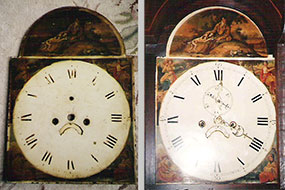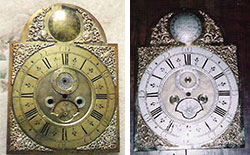Clock Repair & Restoration
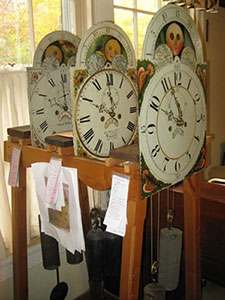 Since 1982, Mark has been working to perfect his craft as a clockmaker. He works on the following:
Since 1982, Mark has been working to perfect his craft as a clockmaker. He works on the following:
- Carriage clocks, ship's clocks and other clocks with hairsprings and balance escapements
- French and Viennese clocks with their fine pivots and gearings
- Antique English spring driven clocks with fusees and complicated designs that sometimes include automation
- All forms of antique and modern grandfather clocks.
His favorite is the repair and restoration of the weight driven antique long case (circa 1600-1850) and the complicated tubular bell clocks of the late 1800's and early 1900's, all of which are commonly referred to as "grandfather" clocks.
Contact us to make an appointment for any form of clock or dial repairs in Ashland, Virginia.
804-752-6633
|
Three fine examples of antique American long case clocks. The work done to these clocks varied with their condition. Dial and case work was done as needed. |
   |
|
|
|
Bracket clocks are probably the earliest form of spring driven clocks. They usually have very
heavy barrel encased mainsprings connecting to the gear train using
chains or gut cables running to fusées. Fusées are The movements are very heavy and as large or larger than most long case movements. In general, these clocks require a more complex repair because of the archaic escapements and complicated striking systems used in most of them as well as the complications added by the use of fusees and mainsprings. The photograph at the right is a side view of the antique London fusée movement from the bracket clock pictured at left.
|
|
|
French clock movements are usually round, have light weight strength mainsprings and tiny pivots, and are built to very precise standards. Because of their fine construction, they can be perceived as finicky, but when in good order and set up properly, they will give very satisfactory service. As
evidenced by both clocks pictured, cases are finely made
and often very elegant. |

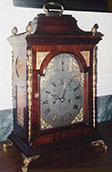

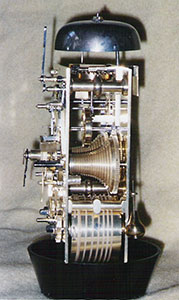 devices used to
equalize the mainspring power to the gear train whether the mainspring
is wound up tight or winding down.
devices used to
equalize the mainspring power to the gear train whether the mainspring
is wound up tight or winding down. 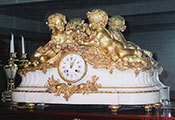
 The clock pictured on the right is an
exceptional example of a French mantle clock.
The clock pictured on the right is an
exceptional example of a French mantle clock.